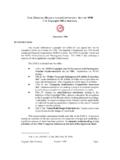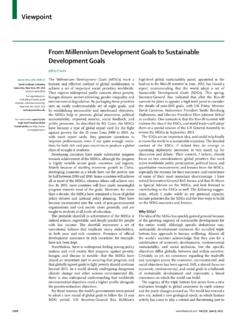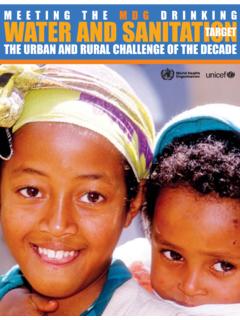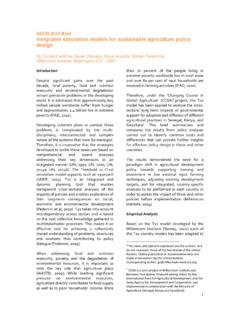Transcription of Reversing the Incidence of Malaria 2000–2015 - …
1 Reversing the Incidence of Malaria 2000 2015 Achieving the Malaria MDG TargetReversing the Incidence of Malaria 2000 2015 WHO Library Cataloguing-in-Publication DataAchieving the Malaria MDG target: Reversing the Incidence of Malaria - prevention and control. epidemiology. Evaluation. Health Organization. 978 92 4 150944 2 (NLM classification: WC 765) World Health Organization and the united nations Children s Fund 2015 This joint report reflects the activities of the World Health Organization (WHO) and the united nations Children s Fund (UNICEF).All rights reserved. Publications of the World Health Organization are available on the WHO website ( ) or can be purchased from WHO Press, World Health Organization, 20 Avenue Appia, 1211 Geneva 27, Switzerland (tel.: +41 22 791 3264; fax: +41 22 791 4857; e-mail: for permission to reproduce or translate WHO publications whether for sale or for non-commercial distribution should be addressed to WHO Press through the WHO website ( ).)
2 The designations employed and the presentation of the material in this publication do not imply the expression of any opinion whatsoever on the part of either UNICEF or WHO concerning the legal status of any country, territory, city or area or of its authorities, or concerning the delimitation of its frontiers or boundaries. Dotted lines on maps represent approximate border lines for which there may not yet be full mention of specific companies or of certain manufacturers products does not imply that they are endorsed or recommended by either UNICEF or WHO in preference to others of a similar nature that are not mentioned. Errors and omissions excepted, the names of proprietary products are distinguished by initial capital reasonable precautions have been taken by UNICEF and WHO to verify the information contained in this publication.
3 However, the published material is being distributed without warranty of any kind, either expressed or implied. The responsibility for the interpretation and use of the material lies with the reader. In no event shall either UNICEF or WHO be liable for damages arising from its production: WHO Global Malaria and layout: credits | Front cover: The Global Fund/Guy Stubbs | pp. iv, 5: The Global Fund/John Rae | p. 2: UNICEF/Olivier Asselin | p. 7: The Global Fund/Didier Ruef | p. 9: The Global Fund/Bruno Abarca | p. 12: WHO/Christopher Black | p. 19: Jhpiego/William Brieger | p. 23: UNICEF/Christine NesbittPlease consult the WHO Global Malaria Programme and UNICEF websites (respectively and ) for the most up-to-date version of all documentsPrinted by the WHO Document Production Services, Geneva, SwitzerlandContents Contents Foreword 1 Acknowledgments 3 Abbreviations 3 Introduction 41.
4 Malaria es s entials Biology and epidemiology Fighting Malaria 72. Indicator : Incidence and death rates as s ociated with Malaria Global progress Progress at regional and country level Cases and deaths averted Challenges 133. Indicator : Proportion of children under 5 s leeping under ins ecticide-treated mos quito nets Progress Remaining challenges 174. Indicator : Proportion of children under 5 with fever who are treated with appropriate antimalarial drugs Progress Reducing bottlenecks to accessing an ACT The need for increased diagnostic testing 225. Beyond MDG 6 Malaria control s contribution to achievement of other MDGs Drivers of change Looking to the future 26 References 28 Annex 1. Es timated Malaria cas es and deaths , and Incidence and death rates , by MDG region 2000, 2005, 2010 and 2015 29 Annex 2.
5 Methods and s ources of data 30 Achieving the Malaria MDg tArget: Reversing the Incidence of Malaria 2000 2015 | iiiiv | Achieving the Malaria MDg tArget: Reversing the Incidence of Malaria 2000 2015 ForewordFifteen years ago, global leaders identified Malaria as a serious public health challenge and one of the biggest impediments to global development, particularly in the world s poorest countries. At a meeting of the united nations General Assembly, they pledged to halt and begin to reverse the Incidence of Malaria by 2015 a critical global target of the millennium Development , we can say with confidence and great excitement that the world has achieved this target. Between 2000 and 2015, the rate of new Malaria infections declined globally by an estimated 37 per cent. Over the same period, the global Malaria death rate fell by 60 per cent.
6 Equally encouraging, an increasing number of countries have moved towards Malaria elimination. Last year, 13 countries reported zero cases of Malaria within their own borders and six countries reported fewer than 10 figures translate into million lives saved over the last 15 years an enormous victory for families, communities, and report highlights these and other key findings, as well lessons we have learned and the challenges that the last 15 years, the delivery of core Malaria interventions has undergone an unprecedented expansion. Since 2000, one billion insecticide-treated mosquito nets have been distributed in Africa. The introduction of rapid diagnostic tests has made it possible to distinguish more quickly between malarial and non-malarial fevers enabling more timely and appropriate treatment.
7 Artemisinin-based combination therapies (ACTs) have been highly effective against Plasmodium falciparum, the most prevalent and lethal Malaria parasite affecting humans. And as we have reached more communities and people at risk for Malaria with these core interventions, many more lives have been in reaching children under the age of 5 one of the most vulnerable groups affected by Malaria has been especially encouraging. By 2015, an estimated 68 per cent of under-fives in sub-Saharan Africa were sleeping under insecticide-treated nets, compared to less than 2 per cent in 2000. Over a 15-year period, the under-five global Malaria death rate fell by 65 per Malaria control is one of the first great public health success stories of this millennium but our work is far from finished.
8 Billions of people remain at risk for Malaria . More than four hundred thousand people, 70 per cent of whom are children under five, still die from this preventable disease every this report shows, serious bottlenecks remain in providing full access to Malaria prevention, diagnostic testing and treatment, especially for children under five and pregnant women. Progress has been uneven, with some countries carrying a disproportionately high share of the global burden. Fifteen countries mainly in sub-Saharan Africa account for 80 per cent of Malaria cases and 78 per cent of deaths Malaria on a global scale is possible but only if we overcome these barriers and accelerate progress in these high-burden countries. They and we have much to gain if we do: Not only lives saved, but also in more sustained economic the global community commits to a new global development framework the Sustainable Development Goals we must strengthen our efforts to achieve universal access to Malaria prevention, diagnosis and this year, the World Health Assembly adopted the WHO Global technical strategy for Malaria 2016 2030, a 15-year roadmap for Malaria control.
9 The strategy sets ambitious global targets, including a further 90 per cent reduction in Malaria Incidence and mortality by the year these targets will require political will, country leadership, and significantly increased investment. To meet the first milestone of this strategy, a 40 per cent reduction in Malaria Incidence and mortality rates, an annual investment of approximately US$ billion per year by 2020 will be needed far more funding than is currently if we secure the required resources and expand access to the core interventions we know are working, we will not only save millions of lives, though this goal is reason enough to act. We will accelerate progress towards a Malaria -free world and transform our common goal into a shared Lake Dr.
10 Margaret Chan Executive Director Director-General UNICEF WHOA chieving the Malaria MDg tArget: Reversing the Incidence of Malaria 2000 2015 | 12 | Achieving the Malaria MDg tArget: Reversing the Incidence of Malaria 2000 2015 AcknowledgementsThis report was prepared by Agbessi Amouzou, Valentina Buj and Liliana Carvajal (UNICEF, New York) and Richard Cibulskis and Cristin Fergus (World Health Organization [WHO] Global Malaria Programme, Geneva). The report also benefited from inputs from Annemarie Meyer ( Malaria No More, united Kingdom) and from Andrea Bosman, Michael Lynch and Saira Stewart (WHO Global Malaria Programme).Yue Chu, Li Liu and Jamie Perrin (Johns Hopkins Bloomberg School of Public Health) and Dan Hogan (WHO Department of Health Statistics and Information Systems) prepared Malaria mortality estimates in children aged under 5 years on behalf of the Maternal and Child Epidemiology Estimation Group.

















